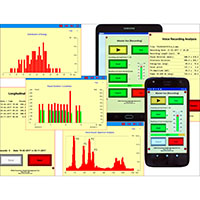Monitoring the effects of therapeutic interventions in depression through self-assessments

All claims expressed in this article are solely those of the authors and do not necessarily represent those of their affiliated organizations, or those of the publisher, the editors and the reviewers. Any product that may be evaluated in this article or claim that may be made by its manufacturer is not guaranteed or endorsed by the publisher.
Authors
The treatment of major psychiatric disorders is an arduous and thorny path for the patients concerned, characterized by polypharmacy, massive adverse side effects, modest prospects of success, and constantly declining response rates. The more important is the early detection of psychiatric disorders prior to the development of clinically relevant symptoms, so that people can benefit from early interventions. A well-proven approach to monitoring mental health relies on voice analysis. This method has been successfully used with psychiatric patients to ‘objectively’ document the progress of improvement or the onset of relapse. The studies with psychiatric patients over 2-4 weeks demonstrated that daily voice assessments have a notable therapeutic effect in themselves. Therefore, daily voice assessments appear to be a lowthreshold form of therapeutic means that may be realized through self-assessments. To evaluate performance and reliability of this approach, we have carried out a longitudinal study on 82 university students in 3 different countries with daily assessments over 2 weeks. The sample included 41 males (mean age 24.2±3.83 years) and 41 females (mean age 21.6±2.05 years). Unlike other research in the field, this study was not concerned with the classification of individuals in terms of diagnostic categories. The focus lay on the monitoring aspect and the extent to which the effects of therapeutic interventions or of behavioural changes are visible in the results of self-assessment voice analyses. The test persons showed an over-proportionally good adherence to the daily voice analysis scheme. The accumulated data were of generally high quality: sufficiently high signal levels, a very limited number of movement artifacts, and little to no interfering background noise. The method was sufficiently sensitive to detect: i) habituation effects when test persons became used to the daily procedure; and ii) short-term fluctuations that exceeded prespecified thresholds and reached significance. Results are directly interpretable and provide information about what is going well, what is going less well, and where there is a need for action. The proposed self-assessment approach was found to be well-suited to serve as a health-monitoring tool for subjects with an elevated vulnerability to psychiatric disorders or to stress-induced mental health problems. Daily voice assessments are in fact a low-threshold form of therapeutic means that can be realized through selfassessments, that requires only little effort, can be carried out in the test person’s own home, and has the potential to strengthen resilience and to induce positive behavioural changes.
How to Cite

This work is licensed under a Creative Commons Attribution-NonCommercial 4.0 International License.






